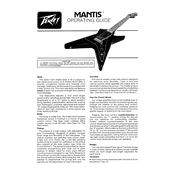Peavey Mantis Operating Guide


To change the strings on your Peavey Mantis Guitar, first loosen the old strings by turning the tuning pegs counterclockwise. Remove the bridge pins and old strings. Insert the new strings through the bridge holes, replace the bridge pins, and wind the strings onto the tuning pegs while maintaining tension. Finally, tune the guitar to your desired pitch.
Regularly clean the guitar body with a soft cloth, ensure the fretboard is conditioned with lemon oil, check for any loose hardware, and keep the guitar in a stable environment to avoid humidity and temperature fluctuations. Change strings as needed and have the guitar professionally set up at least once a year.
Buzzing sounds can be caused by various factors. Check if the strings are properly seated in the nut and bridge. Ensure the neck relief is adequate by adjusting the truss rod. Also, verify that the guitar is properly tuned and that the frets are not worn. If the issue persists, consult a professional technician.
First, check all connections to ensure they are secure. Replace the battery if your guitar has active electronics. Inspect the output jack and ensure it is making proper contact. If problems continue, the issue might be with the internal wiring or components, which should be addressed by a qualified guitar technician.
Adjusting the action involves raising or lowering the strings to suit your playing style. This can be done by adjusting the truss rod for neck relief and raising or lowering the bridge saddles. It is recommended to have this adjustment performed by a professional to avoid damage.
The Peavey Mantis Guitar typically uses humbucker pickups. To replace them, first remove the strings, unscrew the old pickups, and disconnect the wiring. Install the new pickups by reversing the process, ensuring proper wiring according to the pickup manufacturer's instructions.
Store your guitar in a hard case to protect it from physical damage. Keep it in a temperature-controlled environment, away from direct sunlight and humidity. Consider using a dehumidifier or humidifier to maintain ideal conditions. Detune the strings slightly if the guitar will be stored for an extended period.
Signs that your guitar needs a professional setup include persistent tuning issues, high or uneven action, fret buzzing, and poor intonation. If you notice any of these issues, it's time to have a technician evaluate and adjust your guitar.
To clean the fretboard, remove the strings and gently rub the fretboard with a soft cloth and a small amount of lemon oil. Be careful not to over-saturate the wood. This will remove dirt and condition the wood, keeping it in good playing condition.
Ensure the tuning pegs are tightened and not slipping. Check the nut slots to make sure they are not binding the strings. Verify that the strings are properly wound around the tuning pegs. If you frequently bend notes, consider installing locking tuners.